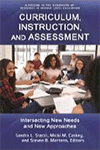
Curriculum, Instruction, and Assessment
Intersecting New Needs and New Approaches
Edited by:
Sandra L. Stacki, Hofstra University
Micki M. Caskey, Portland State University
Steven B. Mertens, Illinois State University
A volume in the series: The Handbook of Research in Middle Level Education. Editor(s): Steven B. Mertens, Illinois State University. Micki M. Caskey, Portland State University.
Published 2020
The lives of middle school students are dynamic, and their needs and desires are always evolving. They experience more complicated lives as influences of the broader society including popular media and technology, immigration and cultural diversity, amplified political divisiveness, and bullying effect their daily lives both in and out of school. These influences have contributed to the need for more socialemotional support and the desire of students and teachers alike to find and express their voices. Since the publication of the 2002 Handbook volume focusing on curriculum, instruction, and assessment, the ideas, approaches, and practices of middle school educators and researchers have also needed to evolve and change in many ways to meet these changing realities and the needs of students, teachers, and schools. This volume includes chapters focusing on varying aspects of curriculum, instruction, and assessment currently being implemented in middle grades classrooms across the country.
CONTENTS
Foreword. Acknowledgments. Introduction. Student-Centered Learning: Evolving Curriculum, Instruction, and Assessment—Intersecting New Needs, Sandra L. Stacki, Micki M. Caskey, and Steven B. Mertens. SECTION I: SEEING THE POSSIBILITIES WITH STUDENTS. Historical Thinking in the Middle School Classroom: Integration of Authentic Curriculum, Instruction, and Assessment, Eric B. Claravall and Robin Irey. Science at My Own Pace: The Impact of a Self-Directed Learning Environment on Eighth Grade Life Science Students, Gerald Ardito. “The Rough Writerz”: Young Adolescent Boys Exploring, Constructing, and Recreating Racial Identities in an After School Program, Theresa McGinnis and Andrea Garcia. In Students’ Voices: How Middle School Students Perceive Their Need for Effective Reading Comprehension Strategies, Nancy Akhavan. SECTION II: EXPLORING CURRICULUM, INSTRUCTION, AND ASSESSMENT THROUGH TEACHERS’ DISPOSITIONS AND PERSPECTIVES. Culturally Relevant Pedagogy and Connectivism: Disciplinary Literacy Challenges in Linguistically Diverse STEM Classrooms in the Middle Grades, Ebony Terrell Shockley, Kelly K. Ivy, and Maria Peters. Pedagogical Responses to Technology in the Middle Level Classroom: The Influence of Digital Tools on Instructional Methodologies and Learning Practices, Lorraine Radice. Shifting Toward Productive Beliefs for Black Students in the Mathematics Classroom, Christa Jackson and Ashley Delaney. Middle Level Teachers’ Educational Technology Use: Challenges, Barriers, and Successes, Thomas M. Brinthaupt, Scott B. Haupt, Richard P. Lipka, and Jill A. Robinson. SECTION III: EXAMINING LEARNING THROUGH BROADER LENSES. Instructional Strategies for Engagement: Cultivating Emotional Awareness and a Challenge-Skill Imbalance, Chris Grodoski, Carrie Dabelow, Crystal Forbes, Margaret Hammer, Michelle Hoffmeyer, Jennifer Jim-Brundidge, and Kurt Makaryk. “How We Are Us”: Using Authentic Assessment in a History Classroom, Colleen Fitzpatrick and Stephanie van Hover. Middle Schoolers’ Writing out of School: (Fear), Freedom, Fluency, and Fellowship in Place-Based Education, Tom Meyer. In the Middle of Next Practices, Barbara J. Mallory and James V. Davis. About the Contributors.
-
Paperback978-1-64802-028-5
Web price: $45.04 (Reg. 52.99)
-
Hardcover978-1-64802-029-2
Web price: $80.74 (Reg. 94.99)
- eBook978-1-64802-030-8

- EDU029000 - EDUCATION: TEACHING METHODS & MATERIALS: General
- EDU007000 - EDUCATION: Curricula
- EDU037000 - EDUCATION: Research
-
 An International Look at Educating Young Adolescents
An International Look at Educating Young Adolescents
-
 Common Planning Time in Middle Level Schools
Research Studies from the MLER SIG’s National Project
Common Planning Time in Middle Level Schools
Research Studies from the MLER SIG’s National Project
-
 Equity & Cultural Responsiveness in the Middle Grades
Equity & Cultural Responsiveness in the Middle Grades
-
 Health and Well-Being in the Middle Grades
Research for Effective Middle Level Education
Health and Well-Being in the Middle Grades
Research for Effective Middle Level Education
-
 Preparing Middle Level Educators for 21st Century Schools
Enduring Beliefs, Changing Times, Evolving Practices
Preparing Middle Level Educators for 21st Century Schools
Enduring Beliefs, Changing Times, Evolving Practices
-
 Research on Teaching and Learning with the Literacies of Young Adolescents
Research on Teaching and Learning with the Literacies of Young Adolescents
-
 Voices from the Middle
Narrative Inquiry By, For and About the Middle Level Community
Voices from the Middle
Narrative Inquiry By, For and About the Middle Level Community

